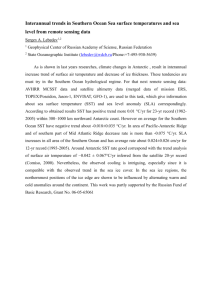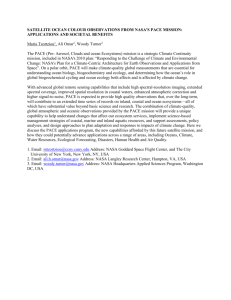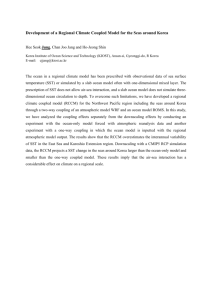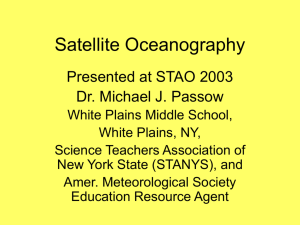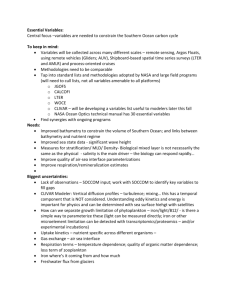Ocean Time Series Data Products from Systematic
advertisement
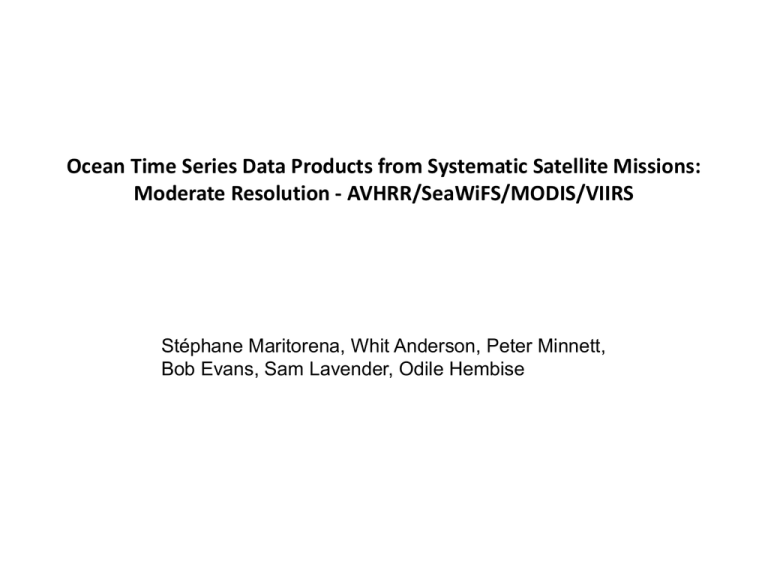
Ocean Time Series Data Products from Systematic Satellite Missions: Moderate Resolution - AVHRR/SeaWiFS/MODIS/VIIRS Stéphane Maritorena, Whit Anderson, Peter Minnett, Bob Evans, Sam Lavender, Odile Hembise Science and Applications OC and SST OC and SST are important variables for • Climate variability, trends • Weather and ocean forecasting • Ocean and atmospheric models (forcing, data assimilation and validation) • Primary Production • Carbon budget • Heat transfer • … Satellite data provide best mechanism for producing globally consistent data sets. SST NPP SST NPP NPP Changes (%) SST Changes ( 0C ) +3 +60 a +2 +1 0 -1 -2 -3 b +30 0 -30 -60 c A few SST time-series Time-Series Data Spatial Resolution Temporal resolution Time period GHRSST L2P L4 1/4 degree - 6km Daily 1985 - Present 4.5 km – 9 km Daily 8-Day Monthly Annual Feb. 2000 – Present (T) Jul. 2002 – Present (A) 4 km Daily 5 Day 7 Day 8 Day Monthly Annual 1985 - 2006 2 km – 18 km Weekly Swath Nov. 1981 – Feb. 2001 Aug. 2001 – Oct. 2005 Aug. 2001 - Present 6 km Hourly May 2003 - Present 2 degrees Weekly Monthly 1981 - Present MODIS Thermal IR Mid-IR AVHRR Pathfinder v5 AVHRR MCSST NAVOCEANO Miami GOES (Regional) NCEP Reynolds OI – MCSST In Situ GHRSST-PP • GODAE (Global Ocean Data Assimilation Experiment) HighResolution SST Pilot Project • International project begun in late 2004. • To produce SST fields that contain error statistics for each SST pixel. • The traceability of the accuracy of the SST pixels through the atmospheric correction and cloud screening algorithms is important to establishing confidence in the SST fields. • Validation of satellite derived SSTs from a range of sensors, using various in situ radiometers, each with NIST-traceable calibration, is an important component of this project. NASA Carbon Cycle and Ecosystems Joint Science Workshop April 28, 2008 SST time-series • More than 20 years of data • Highly successful data sets • Merged data sets (thermal IR and microwave, biases correction among sensors) • Perennial (no data gap in sight ?) • NASA MEaSUREs: Merged Ultra High Resolution (1 km) SST product Ocean Color time-series (Level-3) Source ESA GlobCOLOUR SeaWiFS MODIS-AQUA MERIS Products CHL1 (2) TSM CDM BBP K490 nLw(λ) EL555 AOT Cloud Fraction (+ uncertainties for some) Merged http://www.globcolour.info/index.html Spatial resolution 4.5 km 1/4 1 Temporal resolution Daily 8-Day Monthly Time period Sep. 1997 – Present (SeaWiFS) Jul. 2002 – Present (Merged) GlobColour Objectives NASA CC & E - April 28, 2008 Satisfy emerging demand for validated merged ocean colour derived information Demonstrate the current state of the art in merging together data streams from different ocean-colour sensors: MERIS (ESA), SeaWiFS (NASA), MODIS-AQUA (NASA) Provide a long time-series (10 years) of ocean-colour information Demonstrate a global NRT ocean-colour service based on merged satellite data Put in place the capacity to continue production of such time series in the future and to prepare for full exploitation of Sentinel 3 (ESA) As such, be the initial step of the Ocean Colour Thematic assembly Centre, part of the future EU GMES Marine Core Service www.globcolour.info http://www.enviport.org/globcolour/validation/ GlobColour Products European Service for Ocean Colour NASA CC & E - April 28, 2008 Global ocean colour data set at 4.6 km, 1/4°, 1° resolution covering 1997-2008 daily, weekly, monthly products: •Chlorophyll concentration (Chla) •Diffuse attenuation coefficient @ 490nm (Kd490) •Total Suspended Matter •CDM absorption (aCDM443) •Particle backscattering coefficient (bbp443) •Aerosol Optical Thickness (T865) •Exact normalised water-leaving radiance @ 412, 443, 490, 510, 531, 555, 620nm •Water-leaving radiance @ 670, 681, 709nm •Data quality flags •Cloud fraction •Excess of radiance at ~ 555 nm (turbidity index) (EL555) •Error estimates per pixel for each layer MODIS-only, MERIS-only Ocean Color time-series (Level-3) Source NASA OBPG SeaWiFS MODIS-TERRA MODIS-AQUA Products CHL K490 nLw(λ) PAR (SeaWiFS) SST AOT Angstrom coeff. ε_78 Merged CHL Calcite FLH KPAR Zeuph Spatial resolution 4.5 – 9 km Temporal resolution Daily (3-Day – Aqua) 8-Day Monthly Seasonal Yearly Time period Sep. 1997 – Present (SeaWiFS) Feb. 2000 – Present (Terra) Jul. 2002 – Present (Aqua) o Most products are available as Level-2 data o Many other products available through SeaDAS data processing o CZCS (Nov. 1978 – June 1986) and OCTS data are also available ftp://oceans.gsfc.nasa.gov/ http://oceancolor.gsfc.nasa.gov/cgi/level3.pl Ocean Color time-series (Level-3) Cont’d Source Products NASA ReaSON (UCSB) GSM CHL GSM CDM GSM BBP + Confidence intervals SeaWiFS MODIS-AQUA Merged & individual sensors Spatial resolution Temporal resolution 9 km Daily 4-Day 8-Day Monthly Time period Sep. 1997 – Present (SeaWiFS) Jul. 2002 – Present (Merged & Aqua) Data available at: • ftp:ftp.oceancolor.ucsb.edu/pub/org/oceancolor/REASoN/ • OPeNDAP server: http://dap.oceancolor.ucsb.edu/cgi-bin/nph-dods/data/oceancolor/ • NASA GIOVANNI (Monthly): http://reason.gsfc.nasa.gov/Giovanni/ Other local/regional time-series exist, e.g. NOAA’s COASTLOOK Upcoming OC sensors: VIIRS (NPP/NPOES), OCL (S3, ESA), OCM-2 (Oceansat-2, ISRO) ESDRs, CDRs and CAL/VAL Climate Data Records • National Academy of Sciences Report (NRC, 2000): “a data set designed to enable study and assessment of long-term climate change, with ‘long-term’ meaning year-to-year and decade-to-decade change. Climate research often involves the detection of small changes against a background of intense, short-term variations.” • “Calibration and validation should be considered as a process that encompasses the entire system, from the sensor performance to the derivation of the data products. The process can be considered to consist of five steps: – – – – – instrument characterization, sensor calibration, calibration verification, data quality assessment, and data product validation.” NASA Carbon Cycle and Ecosystems Joint Science Workshop April 28, 2008 CAL/VAL GHRSST Matchups Ocean Color Matchups M-AERI cruises and MODIS validation statistics NASA Carbon Cycle and Ecosystems Joint Science Workshop April 28, 2008 ISSUES/CONCERNS Ocean color time-series •Bias among sensors exist.This needs to be reconciled to develop CDRs or ESDRs •Quality issues (aging sensors.e.g. SeaWiFS) ? •Concerns about the possible interruption of the current time-series •Is VIIRS going to be a subPAR ocean color sensor ? Long-time series measurements of SST Multi-decadal time series require accurate measurements from several series of satellites and sensors. All have particular sampling and accuracy problems: – Infrared polar orbiters (AVHRRs, (A)ATSRs, MODIS’s, Met-Op AVHRR/3… VIIRS): · More complex instruments (MODIS, VIIRS) leads to more instrumental artifacts · Limited degrees of freedom for atmospheric corrections – Microwave polar orbiters (AMSR-E… AMSR follow-on GCOM-W ): · Calibration issues · Footprint size · Side-lobe contamination – Infrared geostationary (GOES Imager, MSG SEVIRI… GOES-R ABI ): · No high latitude coverage · Diurnal heating cycle of s/c and instrument (3-axis GOES s/c) NASA Carbon Cycle and Ecosystems Joint Science Workshop April 28, 2008 Concerns about sustaining SST CDRs • Complex instruments need very careful pre-launch characterization • Accurate validation must be sustained throughout s/c missions • Overlap of missions of ~1yr desired NASA Carbon Cycle and Ecosystems Joint Science Workshop April 28, 2008 Concerns about sustaining validation capabilities • CDRs require traceability to NIST standards • For AVHRR, (A)ATSR, MODIS, AMSR-E through M-AERI’s and Calibration Facilities at UM-RSMAS • M-AERI’s > 10yrs old, >3500 sea-days, rely on obsolete components, need replacing • Calibration Facilities must be sustained • Ship-based radiometry for validation must be sustained into the NPOESS era NASA Carbon Cycle and Ecosystems Joint Science Workshop April 28, 2008 Objectives of this breakout • • • • • Discuss the scientific questions and issues that are being addressed by existing space-based observations. Discuss current time series data products and their scientific application Discuss their future as Climate Data Records (CDRs) and/or Earth System Data Records (ESDRs). Discuss calibration/validation, airborne science, in situ observational needs Identify opportunities, recommend priorities, raise issues or concerns Questions: • What are the key products (CDR or ESDR) for understanding the ocean over time ? • What does the carbon cycle and ecosystems community and modelers expect or need of this effort? • What are our biggest challenges in this area, and how do we address them? • Is our list of identified data records complete, or is something missing? • Does the carbon cycle and ecosystems community need to establish priorities for these and other activities, and, if so, how should they be established?

